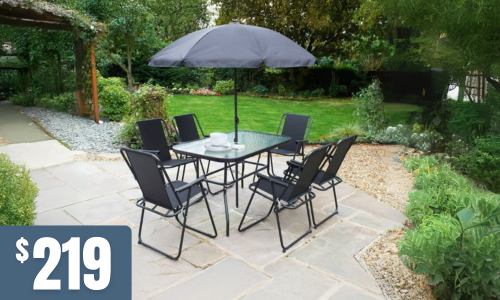Posts tagged with 'retro furniture'
.jpg) In the ever-evolving world of interior design, styles from the past often resurface, and the 60s and 70s are no exception. The swinging 60s and funky 70s were defining decades for furniture trends, characterised by bold colours, unconventional shapes, and a free-spirited approach to design. In this article, we'll embark on a nostalgic journey and explore the resurgence of 60s and 70s furniture trends, highlighting how these retro styles are experiencing a vibrant revival in contemporary British homes.
In the ever-evolving world of interior design, styles from the past often resurface, and the 60s and 70s are no exception. The swinging 60s and funky 70s were defining decades for furniture trends, characterised by bold colours, unconventional shapes, and a free-spirited approach to design. In this article, we'll embark on a nostalgic journey and explore the resurgence of 60s and 70s furniture trends, highlighting how these retro styles are experiencing a vibrant revival in contemporary British homes.
The Swinging 60s: A Burst of Colour and Innovation:
The 60s were marked by a spirit of rebellion and creativity, and this ethos was reflected in furniture design. Here are some key elements of 60s furniture trends:
- Pop Art Influence: The pop art movement had a profound impact on furniture, with its bold use of primary colours and geometric patterns. Furniture pieces often featured eye-catching, vibrant hues.
- Modular Furniture: Modular and multifunctional furniture was popular in the 60s, allowing for adaptability and a sense of individuality in home decor.
- Organic Shapes: The era embraced organic, curvilinear shapes in furniture design, from egg-shaped chairs to circular coffee tables.
- Bold Patterns: Striking patterns like florals, abstracts, and polka dots adorned upholstery, cushions, and curtains.
- Iconic Designs: The 60s introduced iconic furniture pieces, such as the Eames Lounge Chair, the Egg Chair, and the Tulip Table, which remain highly sought after today.
The Funky 70s: An Era of Groovy Style:
The 70s brought a groovy and eclectic style to furniture design. Here are some defining characteristics of 70s furniture trends:
- Earth Tones: Earthy colours like avocado green, harvest gold, and burnt orange dominated furniture and decor palettes.
- Wood and Wicker: Furniture materials such as dark wood and wicker were popular, adding warmth and texture to interiors.
- Shag Carpets: Shaggy, deep-pile carpets were a common choice, adding a tactile and retro feel to living spaces.
- Bohemian Influence: The 70s saw the rise of bohemian and hippie aesthetics, with macramé, tapestries, and low seating options becoming fashionable.
- Open Floor Plans: The 70s embraced open floor plans, and furniture designs often aimed to create versatile living spaces.
The Revival of Retro:
So, why are these retro styles making a comeback in contemporary British homes? Here are some reasons:
- Nostalgia: Many people have fond memories of the 60s and 70s, and incorporating elements of these eras into their homes evokes nostalgia and a sense of comfort.
- Timeless Appeal: The bold and unique designs of the 60s and 70s possess a timeless quality that continues to captivate homeowners and designers alike.
- Mixing Eras: Contemporary interior design often involves blending different eras and styles. Retro pieces can add character and a touch of whimsy to modern interiors.
Embracing Retro in Contemporary Decor:
To incorporate 60s and 70s furniture trends into your contemporary decor:
- Choose Statement Pieces: Select iconic retro furniture pieces like a colourful Eames chair or a funky shag rug as statement items.
- Blend with Modern: Pair retro furniture with modern elements to create a balanced and eclectic look.
- Use Retro Accessories: Incorporate retro accessories like lava lamps, vintage posters, or bold-patterned cushions to infuse a touch of nostalgia.
The resurgence of 60s and 70s furniture trends offers an exciting opportunity to embrace the past while infusing your British home with a burst of colour, creativity, and a sense of fun. Whether you opt for a single retro statement piece or go all out with a full-on throwback theme, these trends are a groovy way to add character and personality to your contemporary decor. So, let's dance to the retro revival and celebrate the enduring appeal of these iconic decades in British interior design.
.jpg)
When it comes to furnishing commercial spaces, selecting the right furniture style is crucial. Different business environments have unique requirements and aesthetics, and the choice of furniture plays a significant role in creating the desired atmosphere. Whether you are furnishing an office, restaurant, hotel, or retail store, understanding which commercial furniture styles suit each environment can help you make informed decisions. In this article, we will explore various business environments and the furniture styles that best complement them.
Office Spaces: Office environments often prioritise functionality, professionalism, and productivity. Here are some furniture styles that suit office spaces: Modern and Contemporary: Clean lines, sleek designs, and minimalistic aesthetics characterise modern and contemporary furniture. These styles create a sleek and professional look that is suitable for tech companies, creative agencies, and modern office settings.
Traditional: Traditional furniture styles convey a sense of elegance and sophistication. They are well-suited for law firms, corporate offices, and establishments that prefer a timeless and classic appeal.
Ergonomic: Ergonomic furniture focuses on promoting comfort and proper posture. It is ideal for offices that prioritise employee well-being and want to reduce the risk of work-related injuries.
Restaurants and Cafés: Restaurants and cafés require furniture that enhances the dining experience and reflects the establishment's theme or cuisine. Consider the following styles: Rustic and Industrial: Rustic and industrial furniture styles create a cosy and laid-back atmosphere. They are ideal for casual dining establishments, coffee shops, or farm-to-table restaurants.
Modern and Minimalistic: Clean lines, neutral colours, and sleek designs characterise modern and minimalistic furniture. This style works well for contemporary restaurants or establishments that aim for a modern, upscale vibe.
Vintage and Retro: Vintage and retro furniture styles add a nostalgic charm and evoke a sense of nostalgia. They are suitable for themed restaurants or cafés that want to create a unique and eclectic ambiance.
Hotels and Hospitality: Hotels and hospitality spaces should provide a welcoming and comfortable environment for guests. Consider the following furniture styles: Luxury and Contemporary: Luxury furniture styles exude elegance and opulence. They are suitable for high-end hotels, luxury resorts, and boutique accommodations.
Transitional: Transitional furniture styles strike a balance between classic and contemporary aesthetics. They are versatile and can fit various hotel styles, from upscale to boutique.
Functional and Space-Saving: Hotels often require furniture that is functional and space-saving, especially in smaller rooms or limited spaces. Look for multi-purpose furniture and modular designs to optimise space utilisation.
Retail Stores: Retail environments should prioritise product display and customer comfort. Consider the following furniture styles: Modern and Sleek: Contemporary and modern furniture styles with clean lines and streamlined designs work well in retail stores. They allow the products to take centre stage while creating a visually appealing shopping experience.
Eclectic and Artistic: Eclectic furniture styles with unique designs and artistic elements can add character to retail spaces. This style is suitable for boutiques, concept stores, or stores with a distinct brand personality.
Customised and Modular: Retail spaces often require customisable and modular furniture to accommodate changing displays and layouts. Look for furniture that can be easily reconfigured and adapted to suit the store's changing needs.
Choosing the right furniture style for your commercial space is essential for creating the desired ambiance, functionality, and customer experience. Consider the specific requirements of your business environment, such as offices, restaurants, hotels, and retail stores, and select furniture styles that align with your brand identity, aesthetics, and functional needs. By understanding which commercial furniture styles suit different business environments, you can create a space that enhances productivity, comfort, and customer satisfaction.
Check our commercial grade furniture and add-ons such as sofas, coffee tables, and more!




.jpeg)

 (3).jpeg)
